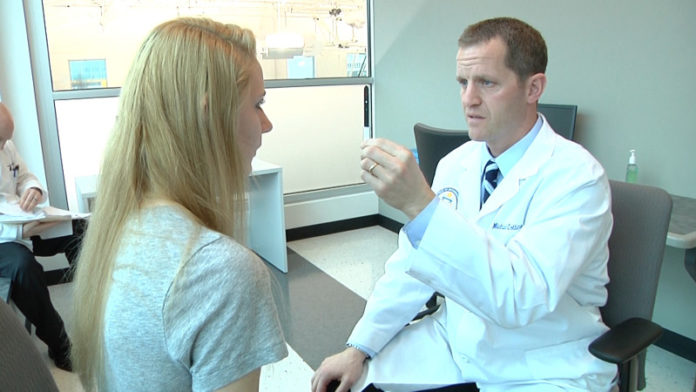
Researchers at UPMC and the University of Pittsburgh have created a new, 5- to 10-minute test that could be added to a clinician’s concussion evaluation toolkit for a more comprehensive assessment of the injury.
In a recent study published online first by the American Journal of Sports Medicine, researchers from the UPMC Sports Medicine Concussion Program demonstrated that clinicians could use their novel Vestibular/Ocular Motor Screening (VOMS) examination to be 90 percent accurate in identifying patients with concussion. The VOMS, which requires such minimal equipment as a tape measure and a metronome, was shown to be a valid and consistent tool to enhance the current multi-disciplinary approaches to concussion assessment that include clinical examination, symptom evaluation and computerized neurocognitive testing.
Previous research conducted at UPMC identified the vestibular ocular system — responsible for integrating vision, balance and movement — as being the most predictive of longer outcomes from sports-related concussions. However, the researchers reported, most current evaluation and management tools for vestibular issues focus on balance, potentially missing important pieces of the concussion puzzle. In fact, the Sideline Assessment of Concussion (SAC), Sport Concussion Assessment Tool-3 (SCAT-3), Balance Error Scoring System (BESS), and similar tests fail to both comprehensively evaluate the vestibular system and measure ocular-motor dysfunction, they added.
“We were afraid that important findings were being missed in many patients following their concussion because we just didn’t have the right tool to measure this part of the injury,” said Anne Mucha, D.P.T., Concussion Program clinical coordinator for vestibular therapy and principal investigator in this research. “Current assessments clearly weren’t sufficient in identifying most of the dizziness and visual problems that we commonly see in our patients.”
“The VOMS is another tool in our toolkit,” said Michael “Micky” Collins, Ph.D., Concussion Program executive and clinical director who took part in this study. “For the past five to 10 years, our research has revealed that vision issues, fogginess and dizziness are symptoms associated with the worst outcomes in our patients. So we set out to create an evidence-based examination to assess these areas.”
The researchers studied 64 concussed patients approximately five days post-injury and 78 healthy control-group patients who were administered VOMS by trained clinicians. The VOMS, which was developed in conjunction with a multi-disciplinary team of UPMC experts, assesses five areas of the vestibular ocular system: smooth pursuits, saccades (rapid eye movement), horizontal vestibular ocular reflex, visual motion sensitivity, and near-point-of-convergence distance. Standardized screening instructions are attached as appendices with the journal paper.
“The results from the current study indicated that more than 60 percent of patients experienced symptoms following the VOMS — and these are patients whose impairments might have been missed without a tool like it,” said Anthony Kontos, Ph.D., Concussion Program assistant research director and senior investigator.
“Current assessment tools are not looking at these issues, which concerns us greatly,” Dr. Collins said. “We are seeing many young athletes who, in addition to neurocognitive deficiencies, are coming to us with vestibular ocular impairment. The VOMS provides a more specific evaluation that can help us better treat these patients using targeted treatment pathways. By integrating the VOMS with current tools, clinicians could very well foster a paradigm shift in concussion diagnosis and management.”
Story Source:
The above story is based on materials provided by University of Pittsburgh Schools of the Health Sciences. Note: Materials may be edited for content and length.
Journal Reference:
- A. Mucha, M. W. Collins, R. J. Elbin, J. M. Furman, C. Troutman-Enseki, R. M. DeWolf, G. Marchetti, A. P. Kontos. A Brief Vestibular/Ocular Motor Screening (VOMS) Assessment to Evaluate Concussions: Preliminary Findings. The American Journal of Sports Medicine, 2014; DOI: 10.1177/0363546514543775
